Music of Haryana
| Music of India | |
|---|---|
 A Lady Playing the Tanpura, c. 1735 (Rajasthan) | |
| Genres | |
|
Traditional Modern | |
| Media and performance | |
| Music awards | |
| Music festivals | |
| Music media | |
| Nationalistic and patriotic songs | |
| National anthem | Jana Gana Mana |
| Regional music | |
| |
Folk music of Haryana has two main forms Classical Folk Music of Haryana and Desi Folk Music of Haryana (Country Music of Haryana),[1] and they take the form of ballads and pangs of parting of lovers, valor and bravery, harvest and happiness.[2]
History
Haryana is rich in musical tradition and even places have even been named after ragas, for example Charkhi Dadri district has many villages named as Nandyam, Sarangpur, Bilawala, Brindabana, Todi, Asaveri, Jaisri, Malakoshna, Hindola, Bhairvi and Gopi Kalyana.[1][3]
Folk music
Types of Folk music
Haryanvi folk music can be classified into two types:[3]
Classical Folk Music of Haryana
The classical form of Haryanvi music is closely associated with and based on Indian classical music.[1] The Indian state of Haryana has produced a number of kinds of folk music, and has also produced innovations in Indian classical music. Hindustani classical ragas are used to sing Alha-Khand (1663-1202 CE) about bravery of Alha and Udal, Jaimal Fatta of Maharana Udai Singh II of Chittor (Maharana Udai Singh was the son of Rana Sanga and the father of famous braveheart Maharana Pratap), Brahmas, Teej festive songs, Phaag songs of Phalgun month of Holi and Holi songs.[1][3]
Country Music of Haryana
The country-side or desi (native) form of Haryanvi music is based on Raag Bhairvi, Raag Bhairav, Raag Kafi, Raag Jaijaivanti, Raag Jhinjhoti and Raag Pahadi and used for celebrating community bonhomie to sing seasonal songs, ballads, ceremonial songs (wedding, etc) and related religious legendary tales such as Puran Bhagat.[1][3] Ahirs also use melodic Raag Pilu on a scale using seven semi-tones.[3]
Kissa folklores of bravery and love such as Nihalde Sultan, Sati Manorama, Jai Singh ki Mrityu, Saran de, etc. are some of the most popular folklores. Rasa lila and "Ragini" are folk theatrical performance Haryana. The Ragini form of theater was popularised by Lakhmi Chand.[2] Kunwar NIhalde or princess Nihalde, was daughter of Hindu king Magh who committed Sati in the pain of separation of her lover and Hindu prince Sultan also called Nar Sultan or Man Sultan, after this she came to be known as Sati Nihalde),[4][5] Singing is a great way of demolishing societal differences as folk singers are highly esteemed and they are sought after and invited for events, ceremonies and special occasions regardless of the caste or status.[2] Songs are based on day to day themes and injecting earthy humor enlivens the feel of the songs. Haryanvi dances have fast energetic movements, and popular dance forms are Khoriya, Chaupaiya, Loor, Been, Ghoomar, Dhamal, Phaag, Sawan and Gugga. Young girls and women usually sing entertaining and fast seasonal, love, relationship and friendship related songs such as Phagan (song for eponymous season/month), Katak (songs for the eponymous season/month), Samman (songs for the eponymous season/month), bande-bandi (male-female duet songs), sathne (songs of sharing heartfelt feelings among female friends).[2] Older women usually sing devotional Mangal Geet (auspicious songs) and ceremonial songs such as Bhajan, Bhat (wedding gift to the mother of bride or groom by her brother), Sagai, Ban (Hindu wedding ritual where pre-wedding festivities starts), Kuan-Poojan (a custom that is performed to welcome the birth of male child by worshiping the well or source of drinking water), Sanjhi and Holi festival. These inter-caste songs are fluid in nature, and never personalized for specific caste, and they are sung collectively by women from different strata, castes, dialects so these songs do change fluidly in dialect, style, words, etc. This adoptive style can be seen from adoption of tunes of bollywood movie songs into Haryanvi songs. Despite this fluid nture, haryanvi songs have a distinct style of their worn.[2]
Traditional Occasions for Music Making
Haryana has rich tradition of dances for various occasions (wedding, festivals, etc.) and seasons (harvest, sowing of seeds, monsoon, etc.). These dances come under one or the other category. Broadly, the following dances are common in one area or the other and performed on specific occasions.[1][3]
Traditional Musicians
The folk music of Haryana has been spread by the Bhats, Saangis and Jogis.[3]
Music Instruments
Music is made using many traditional instruments Sarangi, Harmonium, Chimta, Dhadd, Dholak, Manjeera, Khartal, Damaru, Duggi, Daf, Bansuri, Been, Ghungroo, Dhak, Gharha (by adding rubber cover on top of the pitcher), Thali (beaten with a stick to make music) and Shankha.[1][3]
- Bansuri: wind instrument with an ancient history
- Been - two bamboo pipes fixed in a gourd, associated with snake charmers
- Iktara - a stringed instrument with one string, made from a piece of bamboo with a gourd at one end. Associated with the Jogis. The iktara's two-stringed relative is the dotara.
- Sarangi - a bow instrument, used both in Haryana's folk and classical music
- Shankh - a sacred wind instrument, associated with Vishnu
- Shehnai - wind instrument
Gallery
_Indian_string_instruments%2C_Sarod%2C_Sitar%2C_Iktara_-_Soinuenea.jpg)
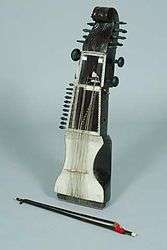
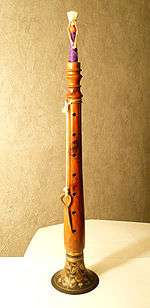
 Harmonium
Harmonium.jpg)
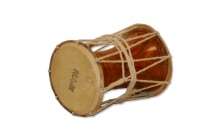


 A pair of Khartal blocks
A pair of Khartal blocks_(8697430998).jpg)
 A woman playing a Daf
A woman playing a Daf Hariprasad Chaurasia playing the Bansuri
Hariprasad Chaurasia playing the Bansuri
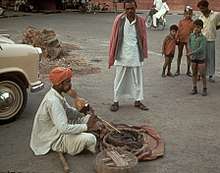 A Snake Charmer playing Been
A Snake Charmer playing Been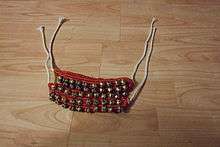 A pair of Ghungroos
A pair of Ghungroos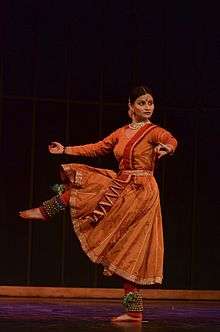 Danseuse with 400 Ghungroos
Danseuse with 400 Ghungroos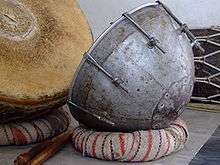
- Gharha is made by adding rubber cover on top of the pitcher
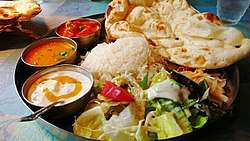 Thali is used to serve food and beaten with a stick to make music
Thali is used to serve food and beaten with a stick to make music Carved Vamavarta Shankhas, circa 11-12th century, Pala period
Carved Vamavarta Shankhas, circa 11-12th century, Pala period
References
See also
External links
Citations
- 1 2 3 4 5 6 7 8 S. C. Bhatt and Gopal K. Bhargava, 2006, Land and People of Indian States and Union Territories: 21 Arts and Crafts of Haryana.
- 1 2 3 4 5 Manorma Sharma, 2007, Musical Heritage of India, Page 65.
- 1 2 3 4 5 6 7 8 9 S. Gajrani, 2004, History, Religion and Culture of India, Volume 1, Page 96.
- ↑ There is also a Tajmahal in Noda, symbol of love of Hindu queen Nihalde and hindu King Nar Sultan, Patrika, 24 May 2017.
- ↑ Kissa Nihalde Sultan: haryanvi ragni
